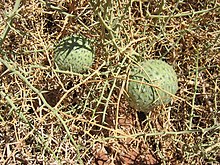Cucurbitoideae
| Cucurbitoideae | |
|---|---|

| |
| Acanthosicyos horridus, a member of the Cucurbitoideae native to Namibia | |
| Scientific classification | |
| Kingdom: | Plantae |
| Clade: | Tracheophytes |
| Clade: | Angiosperms |
| Clade: | Eudicots |
| Clade: | Rosids |
| Order: | Cucurbitales |
| Family: | Cucurbitaceae |
| Subfamily: | Cucurbitoideae Eaton |
| Tribes | |
The Cucurbitoideae are a subfamily of the flowering plant family Cucurbitaceae (gourds). The Cucurbitaceae are divided into two subfamilies, the Zanonioideae, probably a paraphyletic group of remainders, and the well-supported monophyletic Cucurbitoideae.[1]
The subfamily Cucurbitoideae consists of eight tribes. Members of the tribe Cucurbiteae produce economically valuable fruits, called gourds, which include crops like squashes (including pumpkins), luffas, and melons (including watermelons).[2] The tribe Benincaseae contains a genus called Lagenaria whose members produce gourds that can be eaten when young or whose ripe shells can be dried and used as containers.[3]
References[edit]
Wikimedia Commons has media related to Cucurbitoideae.
Wikispecies has information related to Cucurbitoideae.
- ^ Donoghue, Michael J.; Judd, Walter S.; Campbell, Christopher; Elizabeth A. Kellogg; Stevens, Peter F. (2008). Plant Systematics: A Phylogenetic Approach. Sunderland, Mass: Sinauer Associates. ISBN 0-87893-407-3.
- ^ Mabberley, David (2008). Mabberley's Plant-Book: a Portable Dictionary of Plants, their Classification and Uses. Cambridge, UK: Cambridge University Press. ISBN 0-521-82071-5.
- ^ "Lagenaria Ser". Germplasm Resources Information Network (GRIN). United States Department of Agriculture. Archived from the original on October 29, 2013. Retrieved September 2, 2013.
